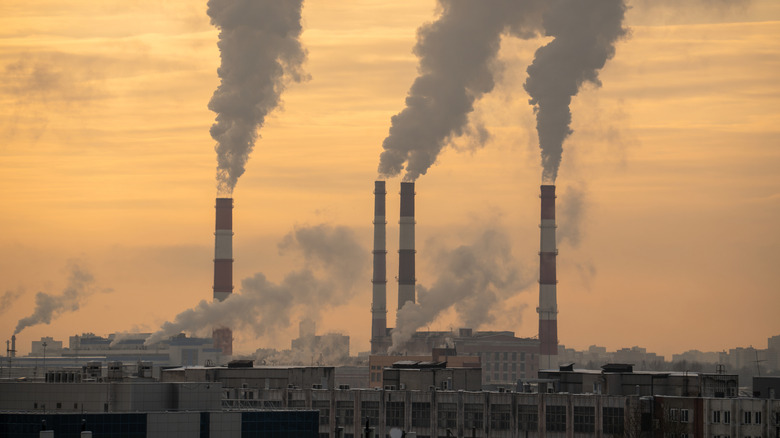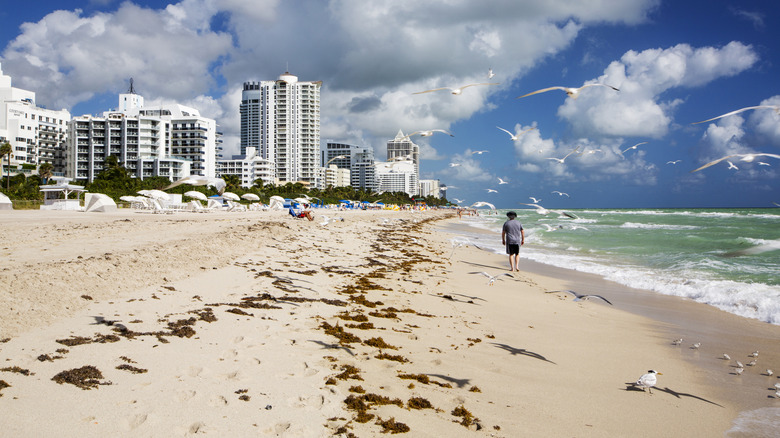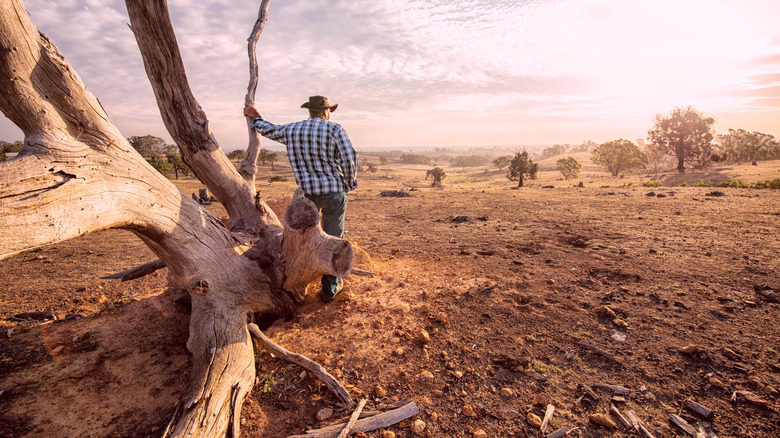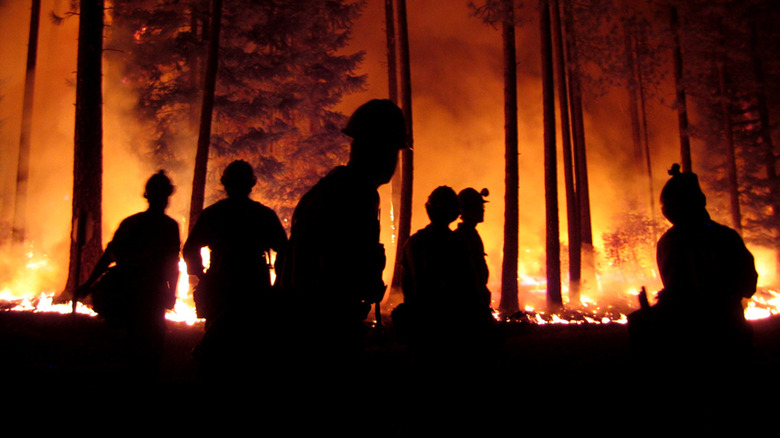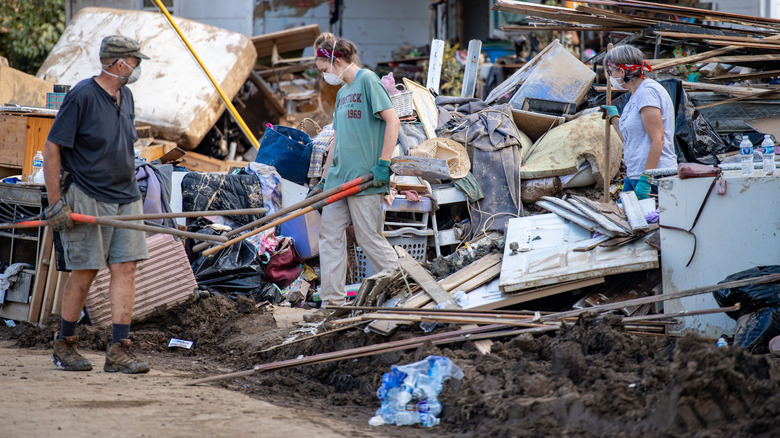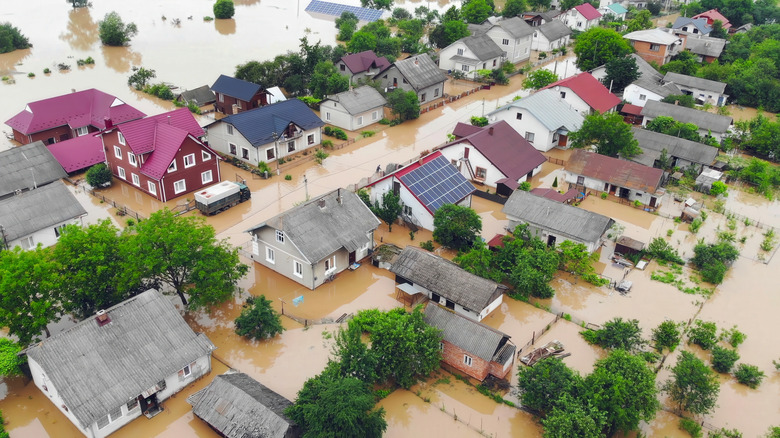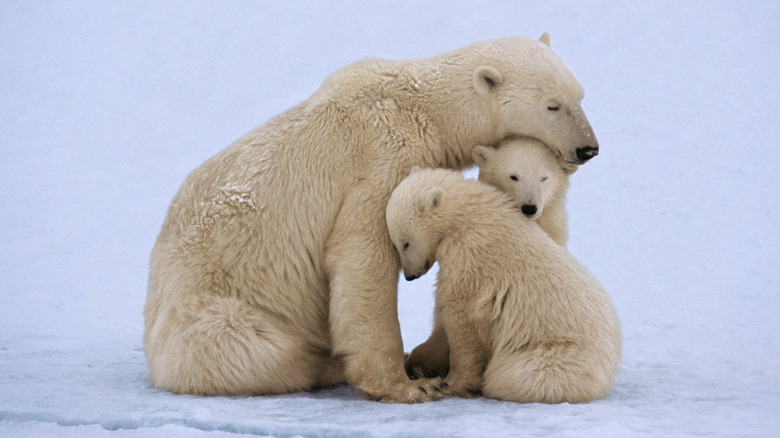The Worst Impacts Global Warming Could Have In The Future
Scientists have long warned of the effects of global warming from human-made greenhouse gases and the properties they possess. It's estimated the planet warmed nearly 2 degrees Fahrenheit between 1850 and 1900, according to a 2021 report by the Intergovernmental Panel on Climate Change. Further, if the planet continues its warming trend to its expected 3 degrees Fahrenheit within the next 30 years, there will likely be irreversible effects.
Among some of these effects include stronger storms, more flooding, and even extinction of some of the world's most vulnerable species. Global warming is also causing changes in jet streams, which are responsible for weather patterns across the globe. As the Arctic regions warm and no longer stand in stark contrast with warm temperatures near the equator, wind currents may ultimately slow down and lead to a variety of drastic changes in the world's climate, with abnormal weather patterns affecting us in new ways. In considering some of the worst impacts global warming could cause in the future, experts believe it is imperative to reduce greenhouse gases in the earth's atmosphere while also finding ways to adapt to climate change.
Sea level rises
If you're starting to notice changes in the shoreline of your favorite beach, it's possible this could be related to global warming. Studies have shown that, sea levels have risen an estimated 7.5 inches on a global level since 1870. Unfortunately, the rate is expected to accelerate further due to global warming. In fact, research suggests sea levels can rise an additional foot or more by the year 2100. Needless to say, this could lead to more erosion and a complete loss of coastal communities worldwide. Even major U.S. cities wouldn't be immune to these effects, including New York City. In fact, about 30% of people in the U.S. live near coasts that could inevitably be impacted by sea level rise.
Sea level rises are linked with warming greenhouse gases in multiple ways. First, it's thought warmer global temperatures expand the amount of ocean water on the planet. Also, warm temperatures will inevitably melt ice caps and glaciers near the poles, which will then lead to increased water levels. Some of these effects were realized in 2023, when there was a record high sea level measured at nearly 4 inches above the previous record set in 1993, per the National Oceanic and Atmospheric Administration (NOAA). The only way to minimize these effects is to significantly reduce the amount of greenhouse gases released into the atmosphere.
Severe drought
A drought develops when there is less rain or other forms of precipitation in a season compared to the year prior, and when a drought persists due to lack of rain or snow, it may be defined as severe. Experts believe global warming is the primary cause of severe drought. In the U.S., drought conditions have steadily worsened in the western and southwestern regions since the early 2000s, but the rest of the country is beginning to see drier conditions, too. Also, climate change may impact which regions may experience drought more often in the future, meaning that an area that typically gets a lot of rain or snow could become dry. It's just one part of the global water crisis, and severe drought can also disrupt ecosystems that are not accustomed to more arid conditions.
When you think of a severe drought, you might recall images of shallow lakes, downsized rivers, and dry foliage on plants and trees. However, this is just the surface of a drought's impacts on the earth. A drought can also impact aquifers and soils, which can decrease groundwater. Drier conditions also affect crops and livestock, thereby disrupting food supplies. On top of that, when the ground is too dry from severe drought conditions, it may not be able to take in water when precipitation does occur. Subsequently, this can cause more flooding events.
More wildfires
Another consequence of global warming-induced severe drought may involve wildfires. When conditions are exceptionally dry, fires can spark easily and spread. This can happen from human activities, such as campfires, controlled burns, or cigarettes, but wildfires can also be started from natural factors such as lightning strikes. Another common cause of wildfires is downed power lines or electrical equipment. Overall, experts believe global warming has worsened both the risk and size of wildfires in the western U.S. over the last 20 years, and they expect the amount of land affected to only worsen in the coming decades.
Not only can drought and a related lack or precipitation cause more wildfires, but global warming can increase their scope and intensity. Extreme heat further dries out forests and grasses, which can then become fuel for any fires that spark. Possible solutions to preventing devastation from wildfires include better forest management and less human development in wooded areas, but these unfortunately do not address the underlying climate change that's causing extreme conditions that fuel the fires to begin with.
Heat waves
If you've endured exceptionally warm conditions where you live in the last couple of years, this may unfortunately point to new future weather patterns. 2023 was technically the hottest year on record, but experts believe 2024 will surpass it. The Environmental Protection Agency also notes that the frequency of heat waves in the U.S. have increased in the last decade from an average of two per year to six heat waves every year. What's more, heat waves have been lasting longer, and they are much more intense than in previous decades. Scientists believe such trends will continue if the planet keeps warming up.
While heat waves are undoubtedly uncomfortable, the frequency, intensity, and longer duration of these weather events go beyond inconvenience. Global warming induced heat waves are also deadly, killing more than 1,200 people per year, according to the CDC (via the American Planning Association). Heat waves are particularly dangerous for young children, the elderly, and people who have certain health conditions, such as heart disease or asthma. If annual heat waves become more of the norm, humans may need to take extra precautions to keep safe.
More intense tropical cyclones
The Atlantic hurricane season traditionally runs from June 1 to November 30 every year, whereas the eastern Pacific season ends November 30 but begins slightly earlier on May 15. However, tropical cyclones can certainly develop outside of these windows. On average, the Atlantic hurricane season produces an average of 14 named storms, per NOAA. While experts don't believe global warming will necessarily increase the frequency of hurricanes, climate change is expected to produce more intense storms. This is attributed to warming water temperatures and low wind shear that can cause tropical cyclones to undergo rapid intensification, a phenomenon that causes storms to increase in wind speeds of at least 35 miles per hour within a 24-hour period. For context, there were seven storms that underwent rapid-intensification during the 2024 Atlantic hurricane season, including Hurricane Milton, which transformed from a Category 1 to Category 5 storm within 24 hours. Changes in the jet stream from global warming could also create faster winds, and that could, in turn, make the characteristics of hurricanes more intense.
Hurricanes will still continue as the climate changes, but rapid intensification is expected to be more of the norm, rather than a occasional phenomena. Additionally, the annual hurricane season could also produce an increased number of destructive Category 5 storms. For humans, this not only means more destructive and potentially deadly rainfall, flooding, and wind, but also worsening storm surge along coastal communities.
Severe flooding events
If you've noticed increased incidents of flash flooding, tropical downpours, or snowfall events in your area, such problems could be more commonplace in the future. Scientists believe that warming global temperatures will also cause severe flooding events. This may be a direct effect from an uptick in rainfall from storms. However, climate change is also causing a shift in rainfall patterns across the world, which means certain regions like deserts may be experiencing more rain than they are used to. As a result, the terrain cannot take in all of the increased precipitation.
The exact areas that may be affected by precipitation changes and flooding events from global warming is uncertain. As of right now, scientists believe some regions may have an increase or decrease in rainfall and snow, while others might see no changes. In the U.S., it's thought that northern regions may experience the largest increases in precipitation in the future more generally, although the entire country is susceptible to heavy rain events and subsequent flooding. This even includes drier climates in the southwestern U.S. Also, some researchers believe the Atlantic and Gulf Coast regions will have the highest flooding risks over the next three decades.
Loss of species
Continued global warming and its subsequent changes in the world's climate means that a variety of species will have to adapt. Unfortunately, not all species may survive these drastic changes. If the world maintains its current trajectory of a 2-degree Celsius (more than 3 degrees Fahrenheit) increase in global temperatures,that change will likely help cause the extinction of many plants and animals; it's actually estimated that an additional 18% of Earth's land species will face extinction by 2100. What's more, ocean species will also face extinction as waters get warmer.
Among some of the species most vulnerable to the impacts of global warming include polar bears, green sea turtles, and coral reefs. The loss of other vulnerable species will ultimately disrupt the human food supply as well, including salmon and natural pollinators such as bumblebees. While humans may not be as vulnerable as other species around the world, we are certainly not immune to the impacts of global warming on food, water, and other important means of survival. This underscores the fact that when one species is lost, the impacts can have repercussions for everyone.
